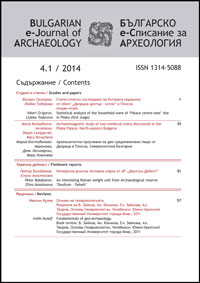Статистическо изследване на битовата керамика от обект „Дворцов център – изток” в Плиска (първи етап)
Statistical analysis of the household ware of ‘Palace centre-east’ site in Pliska (first stage)
Author(s): Valeri Grigorov, Liubka TodorovaSubject(s): Archaeology
Published by: Асоциация на българските археолози
Keywords: Pliska; pottery; statistics; Medieval Period
Summary/Abstract: The article present the first stage of the statistical analysis of the pottery from the ‘Palace centre-east’ site in Pliska. The pottery has been grouped according to technological and functional properties in the following categories: pottery made on slow wheel (pots and bowls), grey pottery (pots and bowls), pottery made on fast wheel (pots, bowls, jars, dishes), amphora-like pitchers (made of light clay or of red clay and pitchers with red slip), amphorae, glazed ware and other categories (Table 1). The database consists of 5648 fragments of household ware found in an area of 200 m2 (Fig.2). The complex analysis of the investigated sector has allowed the determination of three stratigraphic horizons in the post-capital period of Pliska: horizon I (first half of the 10th century AD till the 70s of the same century); horizon II (70s of the 10th century AD till the 30s of the 11th century AD); horizon III (30s-40s of the 11th century AD till 60s of the same century). Various ratios between the different types of pottery are analyzed and presented in different diagrams. The ratio between the three functional groups of pottery - coarse ware, fine ware and storage/transport ware- is 71%:24%:5%. The assessment of the degree of fragmentation was made by the analysis of characteristic fragments (rims and bases). The total number of vessels in the three horizons is different – 12%:57%:31%. Such percentage ratio suggests certain demographic dynamics, according to which the most significant population growth is between the end of the 10th century AD and the first third of the 11th century AD. The detailed analysis of the structure of the pottery assemblage in the post-capital period in Pliska allows inferences to be made not only about the nature of the ceramic production but also serves as a basis for clarification of the social profile of the population, its cultural characteristics and the overall social functioning in the post-capital period of Pliska.
Journal: Българско е-Списание за Археология
- Issue Year: 4/2014
- Issue No: 1
- Page Range: 01-34
- Page Count: 34
- Language: Bulgarian

